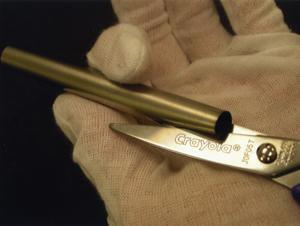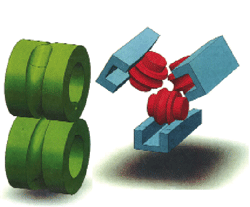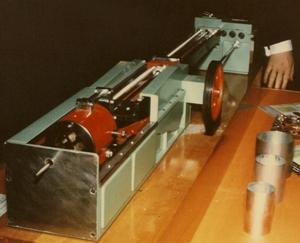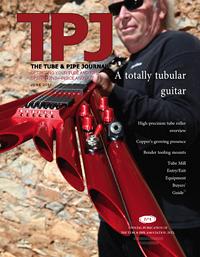Freelance Writer and Intern
- FMA
- The Fabricator
- FABTECH
- Canadian Metalworking
Categories
- Additive Manufacturing
- Aluminum Welding
- Arc Welding
- Assembly and Joining
- Automation and Robotics
- Bending and Forming
- Consumables
- Cutting and Weld Prep
- Electric Vehicles
- En Español
- Finishing
- Hydroforming
- Laser Cutting
- Laser Welding
- Machining
- Manufacturing Software
- Materials Handling
- Metals/Materials
- Oxyfuel Cutting
- Plasma Cutting
- Power Tools
- Punching and Other Holemaking
- Roll Forming
- Safety
- Sawing
- Shearing
- Shop Management
- Testing and Measuring
- Tube and Pipe Fabrication
- Tube and Pipe Production
- Waterjet Cutting
Industry Directory
Webcasts
Podcasts
FAB 40
Advertise
Subscribe
Account Login
Search
HPTR’s past, present, and future — Part I
An overview of the high-precision tube roller
- By Albert Nerino, Mark Deaver, Chris Nagele, and John Reinhart
- June 18, 2011
- Article
- Tube and Pipe Production

Figure 1: An HPTR mill can reduce a titanium tube’s wall thickness by more than 80 percent, resulting in a D/t ratio greater than 100-to-1. The resulting tube has a wall so thin that it is easily cut with children's scissors.
Editor's Note: This article is the first of a two-part series. Part I examines the development, design, and functions of the high-precision tube roller (HPTR). Part II will discuss the HPTR's current role and modern applications.
Technologies do not exist in a vacuum. Instead, they are based on the accumulation of knowledge, processes, tools, and machines. People who work to develop new processes use existing technologies and refine, combine, and improve them to solve a new problem. As part of the process, engineers and inventors ask questions: Can something be done easier? Can it be done more efficiently? Can it be done better? Can it be done at all? By modifying and adapting what already exists, they often find solutions for the problem at hand and, in many cases, develop a machine or a process that remains relevant for future applications.
The high-precision tube roller (HPTR) is one such technology. Its design was based on some of the principles of earlier rolling mills, and in addition to solving a specific problem at the time of its development, it endures today.
Tube Reduction
The basic idea of tube reduction is to cold-work the tube by reducing the diameter, wall thickness, or both, while the displaced material lengthens the tube. Cold-working gives the tube better physical and mechanical properties than it would otherwise have. It also allows tube producers to achieve specific attributes concerning final diameter, wall thickness (see Figure 1), and surface finish. The two most common ways to cold-reduce tubes are tension (see Figure 2) and compression.
Draw benches use tension to pull the tube through a die with an opening slightly smaller than the original tube. While this method creates precise small tubes, the process wastes material on every pass because the ends must be cropped; requires a large number of passes because of the small reduction on each pass; and is difficult to accomplish with metals such as zirconium and titanium and their alloys because of their close-packed hexagonal crystal structure.
Because drawing does not give such metals the desired textures and properties, the preferred method is reduction by compression, which both pilger and HPTR mills use. Rather than pulling the tube through a die, these mills use rollers to compress the tube. Compared with tension, compression can achieve greater reductions per pass, which reduces the number of intermediate steps and increases material yield. It should be noted that pilgers are distinct from HPTR mills in that pilgers use dies with a variable cross-sectional forming groove, and the dies never complete a 360-degree rotation because of their shape (see Figure 3). HPTR mills, by contrast, have a constant cross-sectional groove and complete rotations as they travel along profiled cams.
By the 1950s pilgers and draw benches had proven themselves suitable for most tasks and had become the accepted techniques for tube reduction. Pilgering typically was used either to produce large tubes or to reduce tubes to acceptable feed sizes for cold-drawing mills, which could reduce tubes to small, precise sizes. However, change was afoot. Demand for nuclear reactors was gathering steam; the aerospace industry was taking off; and the Cold War was heating up. The nuclear, aerospace, and defense industries had many uses for small-diameter tubes created to precise standards using exotic, hard-to-draw materials. Furthermore, these industries needed them in large quantities.
For example, zirconium was once simply a lab curiosity, but the metal and its alloys were suddenly in demand because of their effectiveness as fuel cladding for nuclear reactors. Appealing characteristics include low neutron absorption, good corrosion resistance, and relatively high strength at moderately high temperatures. These factors led to the decision to use zirconium as the fuel cladding for the USS Nautilus, the world's first nuclear-powered vessel and darling of America's future nuclear navy.
Russian Ingenuity
The absence of small pilgers at the dawn of the nuclear age, coupled with the disadvantages of cold-drawing zirconium, led Soviet engineers and metallurgists to focus on developing a small tube reducer for fuel cladding. This solution would be the HPTR.
They borrowed from two American inventions. The first was Tadeusz Sendzimir's cluster mill, first developed in the 1930s. This mill used a very small-diameter roll supported by a cluster of larger rolls to reduce metal to thin strip (see Figure 4). The second was the mill developed by Frank Krause in 1938, who came up with the idea of using profiled cams, or support straps, to press a roller into a metal bar or tube to reduce its thickness.

Figure 3: Pilger mills and HPTR mills compress the tube to reduce its size. Both processes use a reciprocating, or back-and-forth, motion. Tooling is a key difference between a pilger mill and an HPTR mill. The grooves of pilger mill tooling have a varying cross-section (left). With each cycle, the tooling does a partial rotation as the tube advances; the tooling then rotates the other direction, to its starting position. HPTR tooling (right) has grooves with a single, constant cross section, allowing it to make complete rotations in both directions.
These techniques were especially useful at the dawn of the nuclear age, in the early 1950s. Reactors required precision tubes made of then-exotic metals such as beryllium, zirconium, vanadium, and molybdenum. Vsevolod Nossal, Alexander Tselikov, and others at the Research Institute of Metallurgical Machine Building in Moscow, or VNIIMETMASH, combined Sendzimir's small roll calculations with Krause's cam roller system to develop the HPTR mill in 1953.
The mills remained on the eastern side of the Iron Curtain for 12 years. They weren't used outside of Eastern Europe until 1965, when the Soviet government sold a mill to a French tube producer, Vallourec. Soon tube producers in Sweden, Poland, West Germany, and Japan began purchasing HPTR mills. In 1969 a U.S. company, Patent Management Inc., completed a licensing agreement with the USSR that resulted in two mills being brought to the U.S. for sale (see Figure 5).
Working Concepts
HPTR mills run on the same concept as dough rolling, whereby the rolling pin is pressed down into the dough as it's rolled forward, stretching and flattening the dough at the same time. The rolls act as the rolling pin, the mandrel acts as the table, and the cams act as the baker's hands (see Figure 6). Three rolls, each paired with a profiled cam, are arranged in a triangle around the tube in what's called the separator, which is itself contained within the housing. The tube's ID is lubricated before loading, and a mandrel is inserted. No special coatings are required beforehand.
The mill cold-works the tube using a reciprocating motion, following a cycle of four basic steps (see Figure 7). In step 1, the housing moves forward. This causes the profiled cams to push the rollers into the tube, compressing it. In step 2, the housing moves back to the start position, with the rollers following the cam until they are once again removed from the tube. In step 3, the tube and mandrel rotate. In step 4, the entire tube is advanced forward slightly. The mandrel is tethered to the rear of the machine and does not advance with the tube.
Results
HPTR mills have several strong points. They can create exceedingly thin-walled-tubes, with tolerances or accuracy to within 0.0005 in. The final tube comes out scratch-free, with uniform mechanical properties. The process also tends to result in a high Q-factor, which is the ratio of the percentages of wall reduction to mean diameter reduction. This is vital in zirconium fuel cladding because it increases its durability. For comparison, a Q-factor greater than 1 is favorable, and a Q-factor above 2.5 is very desirable. HPTR mills typically give a Q-factor between 5 and 15.
Mark Deaver, mechanical engineer; Chris Nagele, manufacturing engineer; and John Reinhart, manager of product development for Superior Tube Co. Inc., contributed to this article.

Figure 5: A fully functional, miniature HPTR mill was used by USSR representatives to provide demonstrations at the 1967 International Engineering & Marine Exhibition in London. The mill's export would greatly change the way tubes were produced in Western Europe and Japan. The large-diameter tubes at the right of the display are samples from the larger sizes of HPTR mills.
About the Authors
Albert Nerino
3900 Germantown Pike
Collegeville, PA 19426
610-489-5296
Mark Deaver
Mechanical Engineer
3900 Germantown Pike
Collegeville, PA 19426
610-489-5296
Chris Nagele
Manufacturing Engineer
3900 Germantown Pike
Collegeville, PA 19426
610-489-5296
John Reinhart
Manager of Product Development
3900 Germantown Pike
Collegeville, PA 19426
610-489-5296
About the Publication
Related Companies
subscribe now

The Tube and Pipe Journal became the first magazine dedicated to serving the metal tube and pipe industry in 1990. Today, it remains the only North American publication devoted to this industry, and it has become the most trusted source of information for tube and pipe professionals.
start your free subscription- Stay connected from anywhere

Easily access valuable industry resources now with full access to the digital edition of The Fabricator.

Easily access valuable industry resources now with full access to the digital edition of The Welder.

Easily access valuable industry resources now with full access to the digital edition of The Tube and Pipe Journal.
- Podcasting
- Podcast:
- The Fabricator Podcast
- Published:
- 04/16/2024
- Running Time:
- 63:29
In this episode of The Fabricator Podcast, Caleb Chamberlain, co-founder and CEO of OSH Cut, discusses his company’s...
- Trending Articles
Team Industries names director of advanced technology and manufacturing

3D laser tube cutting system available in 3, 4, or 5 kW

Corrosion-inhibiting coating can be peeled off after use

Zekelman Industries to invest $120 million in Arkansas expansion

Brushless copper tubing cutter adjusts to ODs up to 2-1/8 in.

- Industry Events
16th Annual Safety Conference
- April 30 - May 1, 2024
- Elgin,
Pipe and Tube Conference
- May 21 - 22, 2024
- Omaha, NE
World-Class Roll Forming Workshop
- June 5 - 6, 2024
- Louisville, KY
Advanced Laser Application Workshop
- June 25 - 27, 2024
- Novi, MI


























